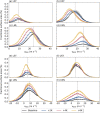Sensitivity of Atmospheric River Vapor Transport and Precipitation to Uniform Sea Surface Temperature Increases
- PMID: 33391965
- PMCID: PMC7771035
- DOI: 10.1029/2020JD033421
Sensitivity of Atmospheric River Vapor Transport and Precipitation to Uniform Sea Surface Temperature Increases
Abstract
Filaments of intense vapor transport called atmospheric rivers (ARs) are responsible for the majority of poleward vapor transport in the midlatitudes. Despite their importance to the hydrologic cycle, there remain many unanswered questions about changes to ARs in a warming climate. In this study we perform a series of escalating uniform SST increases (+2, +4, and +6K, respectively) in the Community Atmosphere Model version 5 in an aquaplanet configuration to evaluate the thermodynamic and dynamical response of AR vapor content, transport, and precipitation to warming SSTs. We find that AR column integrated water vapor (IWV) is especially sensitive to SST and increases by 6.3-9.7% per degree warming despite decreasing relative humidity through much of the column. Further analysis provides a more nuanced view of AR IWV changes: Since SST warming is modest compared to that in the midtroposphere, computing fractional changes in IWV with respect to SST results in finding spuriously large increases. Meanwhile, results here show that AR IWV transport increases relatively uniformly with temperature and at consistently lower rates than IWV, as modulated by systematically decreasing low-level wind speeds. Similarly, changes in AR precipitation are related to a compensatory relationship between enhanced near-surface moisture and damped vertical motions.
Keywords: CC scaling; aquaplanet; atmospheric rivers; attribution; sensitivity.
©2020. The Authors.
Figures












References
-
- AMS (2019). Atmospheric river. Retrieved from https://glossary.ametsoc.org/w/index.php?title=Atmospheric_river&oldid=1988
-
- Butler, A. H. , Thompson, D. W. J. , & Heikes, R. (2010). The steady‐state atmospheric circulation response to climate change like thermal forcings in a simple general circulation model. Journal of Climate, 23(13), 3474–3496. 10.1175/2010JCLI3228.1 - DOI
-
- Chang, E. K. M. , Guo, Y. , & Xia, X. (2012). CMIP5 multimodel ensemble projection of storm track change under global warming. Journal of Geophysical Research, 117, D23118 10.1029/2012JD018578 - DOI
-
- Cordeira, J. M. , Ralph, F. M. , & Moore, B. J. (2013). The development and evolution of two atmospheric rivers in proximity to Western North Pacific tropical cyclones in October 2010. Monthly Weather Review, 141(12), 4234–4255. 10.1175/MWR-D-13-00019.1 - DOI
-
- Davis, N. , & Birner, T. (2013). Seasonal to multidecadal variability of the width of the tropical belt. Journal of Geophysical Research: Atmospheres, 118, 7773–7787. 10.1002/jgrd.50610 - DOI
LinkOut - more resources
Full Text Sources
Research Materials
